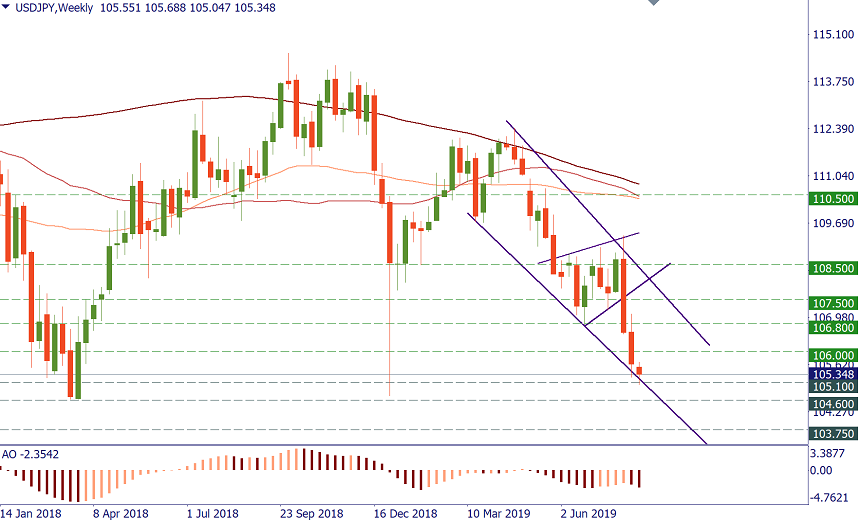August on Forex: hot & cold
A trader always needs perspective. From time to time, it’s necessary to take a broad look at the market and outline the main events, trends, risks, and opportunities. In the article below, FBS analysts have gathered the key info about the main currency pairs. We hope that this analysis will make your trading easier.
News bulletin: key topics
- United States vs. China
Each time everyone thinks that the world’s biggest trade warriors are close to an agreement, the conflict escalates. It seems that both parties are not willing to compromise any time soon. This, in turn, reignites the fear of the worldwide economic suffering in general and the US recession in particular. There are new deadlines: Donald Trump said that he will impose more tariffs on Chinese imports from Sept. 1. Another bone of contention is Chinese telecommunication giant Huawei, which is in the US Department of Commerce’s trade blacklist. To sum up, all of this looks like a big stalemate.
Impact: China’s main weapon is to let the yuan weaken versus the USD. USD/CNH rose above the key level of 7.00 and is in no hurry to get back.
In addition, the riskier currencies (the AUD, the NZD, the CAD) have naturally weakened versus the safe havens (the JPY and the CHF). The Reserve Bank of New Zealand has eased policy more than expected trying to be ahead of the game. If things continue to move in the direction they are moving now, other central banks may get deep into competitive devaluation. As a result, trading will become more volatile. No G10 CB meetings are left in August, but there will be those in September and we remember that the market lives by expectations, so the upcoming event still matters a lot.
- Federal Reserve
One central bank requires particular attention. The Fed’s actions weren’t as dramatic in July as some have thought. Yet, the situation has changed since the end of last month. Traders currently expect the Federal Reserve to cut rates again in September and once more next year. American economic releases will be under the market’s scrutiny for the signs that the trade war is undermining the health of the US economy. The FOMC meeting minutes will come out on Aug. 21. In addition, there will be the annual Fed symposium in Jackson Hole, Wyoming, on Aug. 21-23: the regulator may use the event to deliver the info about the future direction of its monetary policy as it has happened during some of the previous years.
Impact: With this shift in expectations towards a more dovish Fed, the USD is going to remain under pressure versus the JPY as further monetary easing is far more difficult for Japan. The same picture is possible with USD/CHF, although the Swiss National Bank may be more inclined to prevent the CHF from strengthening too much.
- Brexit
British Prime Minister Boris Johnson, who took office at the end of July, has managed to convince the market that the UK will depart from the European Union on Oct. 31 no matter what. There’s also speculation that there may be an election in the days following Brexit. Such an outcome would increase the uncertainty several folds and draw a big question mark over the political and economic future of Britain.
Impact: Although Johnson’s victory in the leadership race had been largely priced in, GBP/USD still fell from 1.25 below 1.21. The selloff below 1.20 would be something new for the GBP. Still, with the uncertainty all over the place and the low odds of a new withdrawal agreement, it’s hard to envisage a relief rally any time soon.
Time of the charts
EUR/USD. Despite the overall downtrend, it doesn’t look like the pair is going to speed up to the downside in the foreseeable future. A “hammer” which formed near 1.11 safeguards the downside, even though the pair’s swimming below the 61.8% Fibo of the 2017-2018 advance. The upside, in its turn, is sealed by 1.1345. The European side of the equation won’t be a market driver, so we bet on the ongoing consolidation.

USD/JPY. With the two weeks of heavy selling, USD/JPY looks vulnerable for more, even though some support was found at 105.50. Below this level, the focus will shift down to 104.60 and 103.75. It looks like recovery above 107.50 won’t be easy.

AUD/USD. The pair fell to the lowest levels since 2009. Short positions got covered around 0.67 and the pair got some relief. Resistance is at 0.6860 and a ceiling for the bullish correction is naturally at 0.70. The return below 0.6750 will allow bears to once again feel stronger and try for more: in 2008 AUD/USD touched 0.60, so further declines are not out of question. Still, there should be either something new and bad between the US and China for that or excessive actions of the RBA. The latter is unlikely within the next 3 weeks.

NZD/JPY. This pair impersonates the current battle of sentiment that’s taking place in the market. Little can be done about the fact that the NZD is fundamentally weaker. As a result, it’s necessary to watch support at 0.69 (50% Fibo of the 2009-2014 advance): weekly close below it can shift the pair to watch much lower targets, such as 63.15 (61.8% Fibo).

Conclusion
Obviously, this August traders won’t get bored. The challenges lying ahead of the global economy are substantial, trade disagreements are intense and the imminent Brexit forms icing on this cupcake. As a result, we can’t help but leave the reminder of how important risk management is for long-term success in trading.